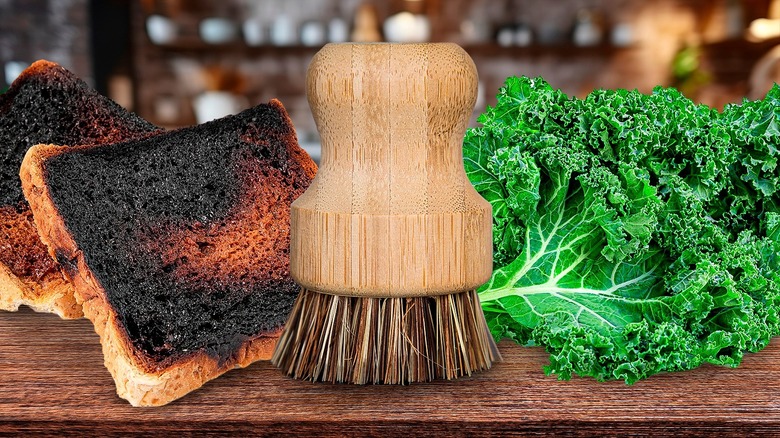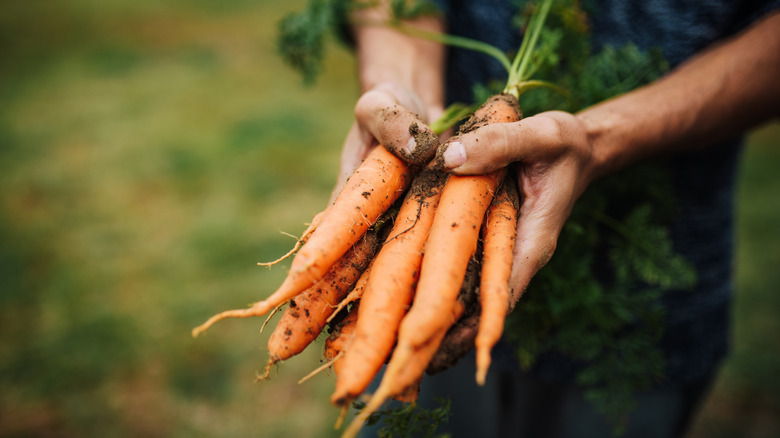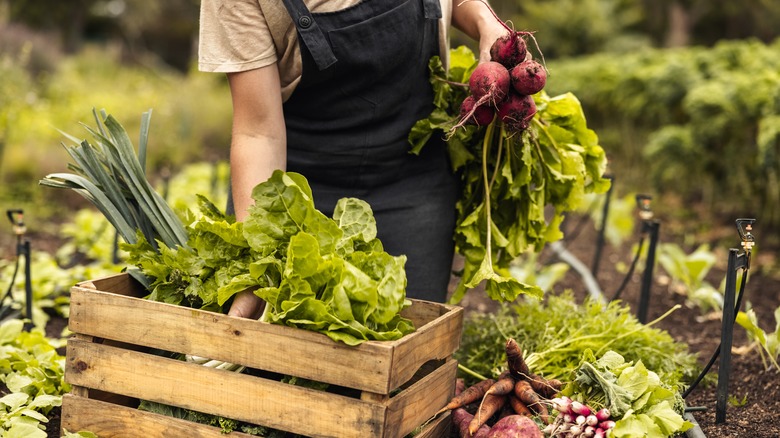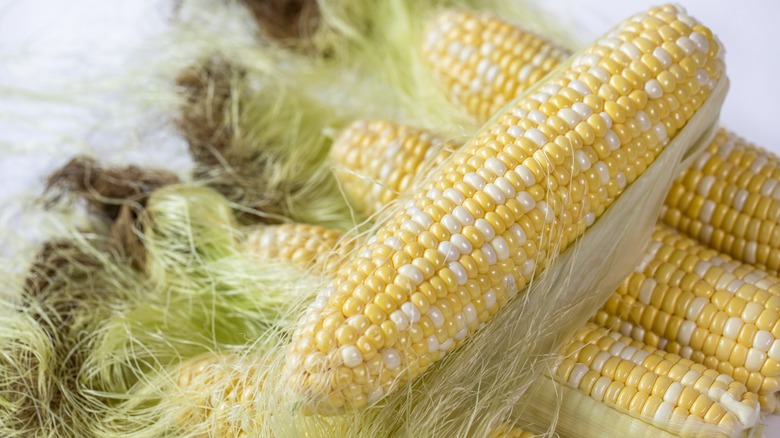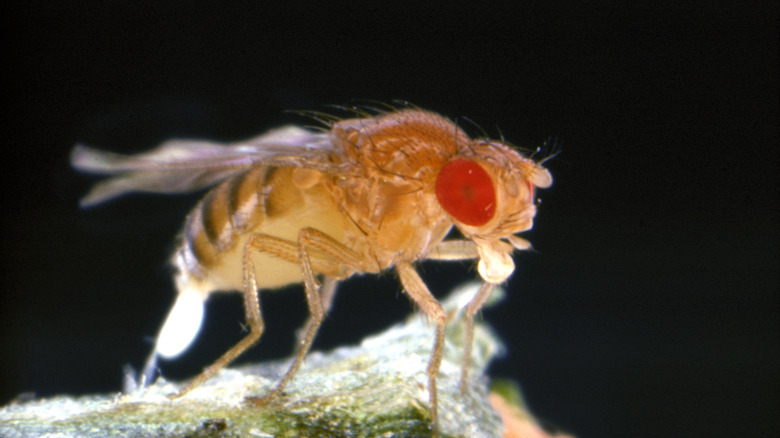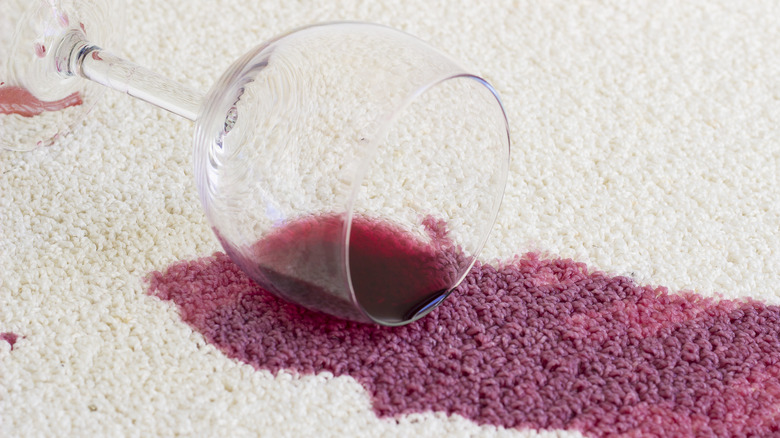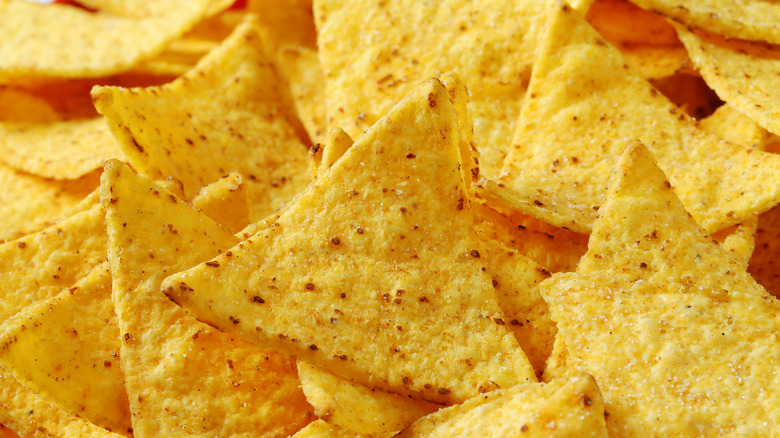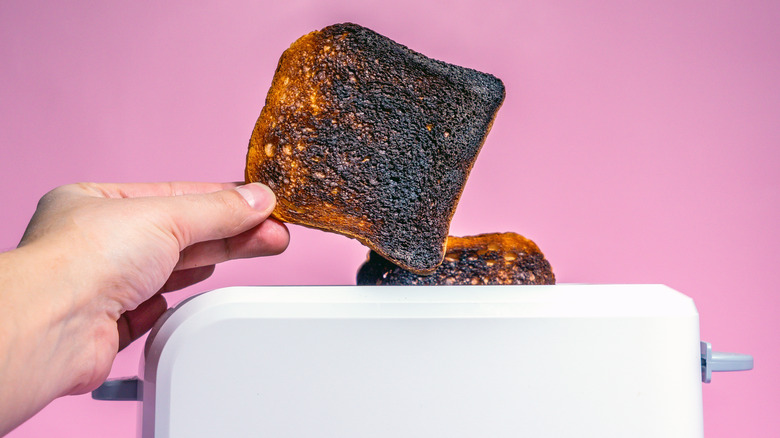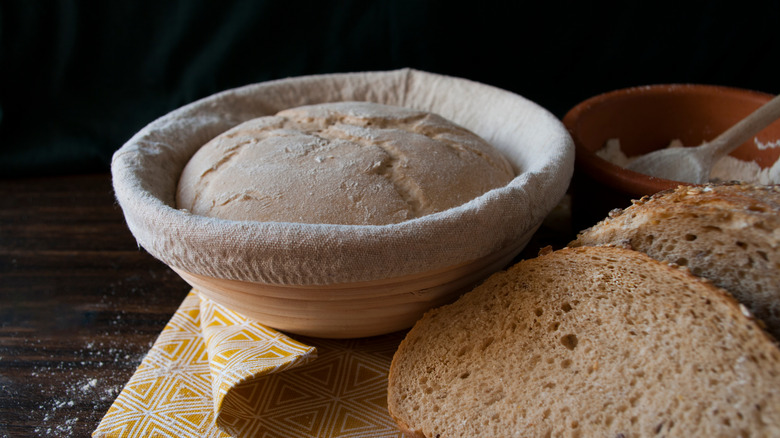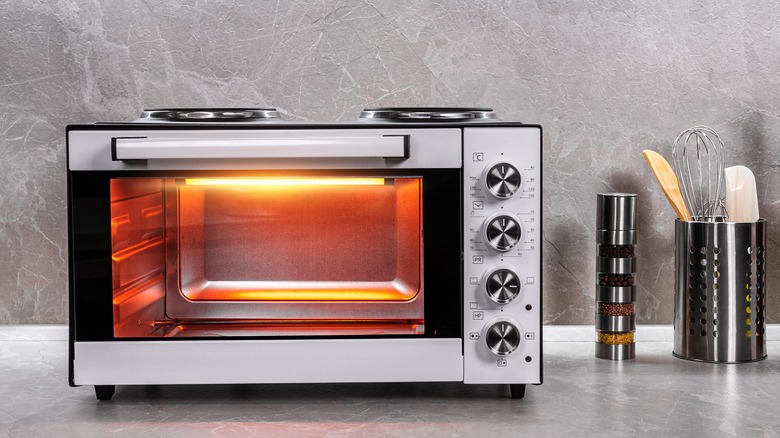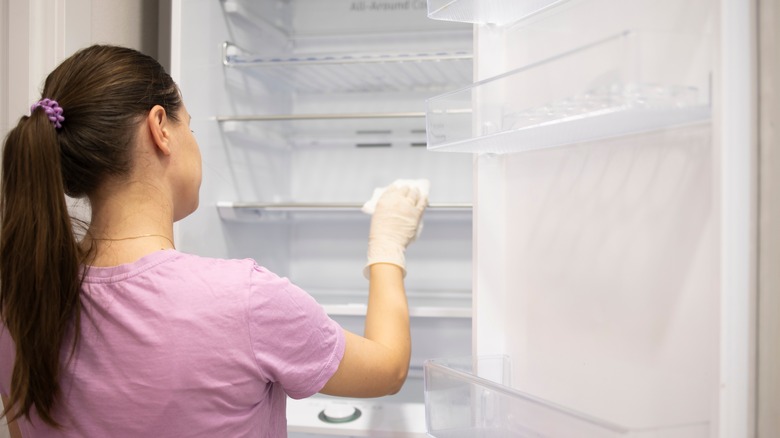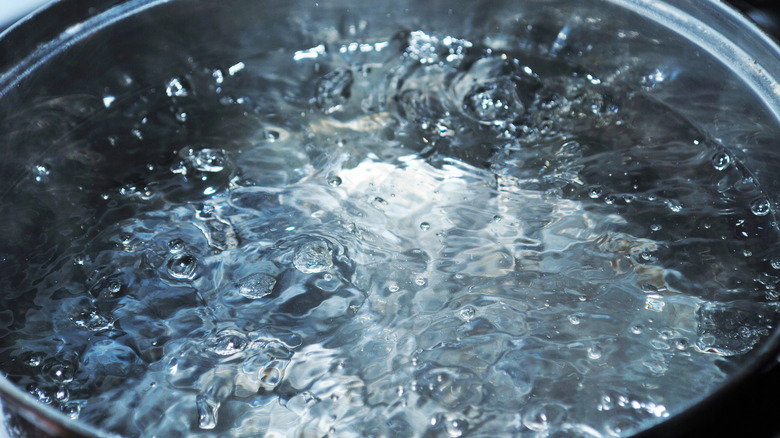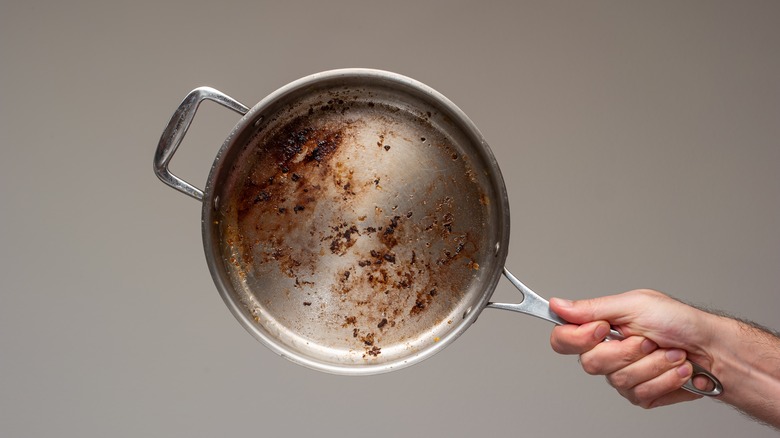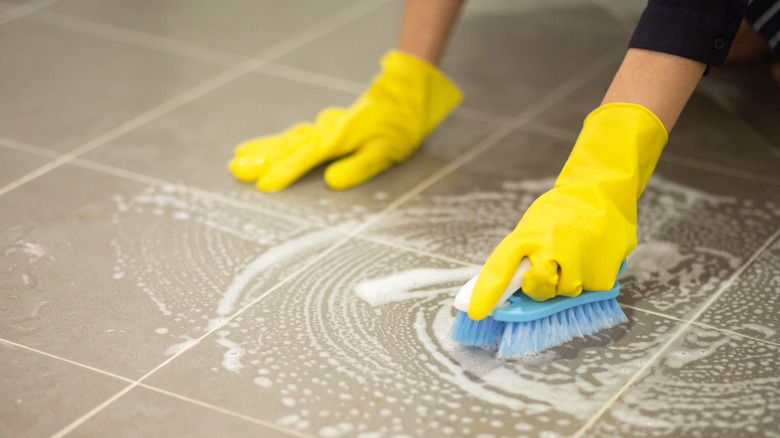13 Great Alternative Uses For A Potato Scrubber
Having the right tools in the kitchen can help make tasks easier, quicker, and more efficient. With today's bustling grind, we've grown accustomed to the convenience tools afford us, and we're all the better for it. But beyond their intended design, the best tools can be used for a range of things. One of the lesser-highlighted kitchen tools, though surprisingly versatile, is the potato scrubber, popularly referred to as a vegetable brush.
Potato scrubbers are specially made to remove dirt particles from not only potatoes, but from similar firm-skinned root vegetables like carrots, parsnips, and beets. Some iterations can also be used to clean citrus fruits, melons, and cucumbers, while others are made for specific vegetables like corn. It all depends on the brand you purchase and the task at hand. In addition to food, potato brushes are remarkably good at cleaning things, too.
Whether removing excess flour from home-baked bread or eliminating red wine stains from your favorite dress shirt, this nifty tool has a multitude of ways to alleviate the kitchen workload. Here are some alternative uses for a potato scrubber.
Clean other firm-skin root vegetables
Unless the idea of dirt-covered veggies turns you off, you're probably no stranger to cleaning it from the fresh produce. Many fruits and vegetables, of course, come from the ground. Non-organic produce may be more aesthetically pleasing, but research shows that organic usually has higher levels of antioxidants and omega-3 fatty acids — while containing lower levels of pesticide residue. The only thing that stands in the way of your organic nutrient boost is a little soil.
As mentioned, potato scrubbers can be used on any firm-skin root vegetable. The best way to clean carrots is with fresh water followed by a good scrubbin'. The bristles on potato scrubbers are designed for hard-to-reach areas. Along with dirt, brushes are great at dislodging root tendrils. It works like a buffer and gives your produce a spit-shine new appearance. Potato scrubbers are one of the most essential tools to have on hand for recipes that call for parsnips, beets, radishes, cassava, or even onions and shallots.
Brush dirt from fresh garden produce
Many people choose pre-washed produce rather than the fresh farmer's market kind. Gardeners (and subscribers to produce boxes) are all too familiar with dirt-covered produce. Some people even consider dirt an indicator of freshness. Produce purists aside, whether you prefer organic or not, the last thing any of us want in our food is dirt. Potato scrubbers aren't only for root vegetables; with the proper care, they can be used for nearly any medium to firm-skinned variety.
A good scrub will produce (pun intended) a store-bought sheen. Removing dirt is necessary to avoid food-borne illnesses from consuming bacteria. The only downside is the extra time it takes to thoroughly clean each vegetable and fruit. The proper way to clean produce is to first wash your hands with warm soapy water for at least 20 seconds before handling. You next want to make sure that your kitchen sink is sanitized. Rinse it with cool water while scrubbing away the dirty clumps. After you finish, dry the produce off with a towel to prevent recontamination.
Easily remove corn silk
Potato scrubbers come in various styles. Although many can be used for any task, there is a version designed especially for removing silk strands from corn. Corn silk is those shiny white-ish strands that are attached to the tassel of an ear of corn. It can be consumed as an herbal tea or taken as a pill but generally is discarded when cooking. The style of vegetable brush for the job is called a "corn de-silking" brush. They come in several designs, some resemble regular potato scrubbers, while others look like small-sized bottle brushes, and even more unique, are the circular-shaped kind that you insert cobs into.
That said, you don't need a fancy brush to get the job done, just a subtle application of elbow grease. You began by peeling off the corn husk, followed by a firm grip on the corn. Next, run your potato scrubber across the length of the corn firm yet gently, and repeat on all sides until it's silk-free. Any remaining strands can be easily wiped off with a damp paper towel.
Help reduce fruit flies in the kitchen
Puny and pesky, fruit flies are some of the most annoying pests to have in a kitchen. They seemingly appear out of thin air in droves, swarming masterfully outside the rim of your periphery. Their endless tendency to multiply has of course inspired everything from sprays and fly traps to a nifty vinegar-in-a-bowl hack. Some of which work well, none of which are perfect. While it may be impossible to completely rid your kitchen life of fruit flies, the more tricks you have up your sleeve, the better.
The fact is that bugs and fruits go hand in hand. Fruit flies infiltrate your culinary sanctuary in several ways, one of the more common is through bananas, berries, and melons. Fruit flies are attracted to overripe fruit, rotting fruits and veggies, dirty drains, and fresh garden produce. Most times, tiny eggs go unnoticed by shoppers, who unknowingly bring them into their homes. That's why it's important to wash fresh produce immediately.
Potato scrubbers can help reduce fruit flies in the kitchen. Use them to brush away egg-infested dirt particles on firm-skinned fruit like apples, papayas, pomegranates, avocados, melons, and more. After a thorough scrub, rinse away any remnants and let the fruit dry on a towel for later consumption.
Eliminate red wine stains on white cloth
When red wine spills on white fabric, it can feel like the end of the world. Red wine stains are infamously hard to remove, and any kneejerk attempt to clean them usually results in further ruin. Even today, with all of our advancements, removing red wine stains is still a challenge. It takes more than cleaning products. Without patience, persistence, and a potato scrubber, the most effective methods will only get you so far.
We recommend applying a blend of clear liquid dish soap and 10 ounces of water to the stain. Next, rather than scrubbing it, use a potato scrubber with soft bristles to tap the stained area. Doing so pushes the wine particles through the fabric, preventing them from setting. This initial step will lighten the stain, but additional steps may be required to remove it completely.
If so, apply vinegar to the stain, let it sit for 20 minutes, then rinse it with water. Depending on the amount of stain, the vinegar should remove it completely. If not, try adding hydrogen peroxide and let it sit for 15 minutes (less if the fabric is thin). Rinse with water. If that doesn't work, you can also try ammonia, an enzyme detergent, and powdered non-chlorinated color-safe bleach.
Brush off overly salty savory snacks
Everyone knows someone with picky eating habits. The friend that carefully removes each mushroom from their pizza slice before taking a bite; the relative that only eats familiar foods and refuses to try new things; there are a wide range of people with particular tastes. Be it dietary restrictions or a simple desire to reduce sodium intake, some are picky for good reason. Take TikToker Morgan (@backomos) for example, who captured a video of her father's hilarious picky eating habit.
Like any regular person, he loves snacking while watching television. The only thing is, before eating his tortilla chips, he uses a paintbrush to brush away the salt. Of course, the obvious question is, "Why not just buy salt-free tortilla chips?" While no explanation is provided, it's perfectly okay for someone to like things the way they like them. The clip is somehow endearing, despite it bordering on wacky. It will surely make the pickiest eater breathe a sigh of relief.
If you fall into the picky category, this paintbrush hack will work just as well with a potato scrubber. Whether tortilla or potato, you can use a potato scrubber to brush off overly salty snacks. That way, you can carefully customize the savoriness to your liking.
Salvage toast by removing burnt layers
Toast is simultaneously one of the easiest things to make as it is to mess up. One notch on the toaster dial control can mean the difference between the perfect char and a crunchy mess. That said, there are some maniacs out there that enjoy overly crunchy, gum-shredding toast. To them, anything lower than a five is blasphemous. If you like taking a walk on the crunchy side of things, you've no doubt burnt a toast or two in your day. While many would toss it in the trash bin, we have a good argument for why you need to stop throwing burnt toast away.
Just because you burn toast, doesn't mean you can't salvage it. With a potato scrubber, you can wrest the edible part free from its burnt outer layer. You start with a cheese grater to scrape away the initial burnt layer, then apply a vegetable brush to remove the remnants. The amount of grating and scrubbing will depend on the level of char. If the char isn't too bad, using this method should reward you with a slice of edible toast.
Brush away excess flour from homemade bread
Baking is as much about precision as it is about making a mess. Even the most skilled home baker falls victim to flour's evasive powder. From recipe to recipe, flour not only adds structure and elasticity to baked goods, but it also keeps them from sticking together and to surfaces. Sufficient flour is needed to knead the dough properly and to prevent the bread from sticking to the bottom of the baking pan. When using a banneton to shape and structure sourdough bread, applying too much flour can impact the end result.
New bakers are often left with a layer of flour on their dough after kneading it in the banneton. A great way to reduce unnecessary flour is with a potato scrubber. Simply brush away the excess before placing the bread in the oven to bake. After baking, if there's still too much flour, you can use the potato scrubber again.
Clean crumby messes from toaster ovens
Along with removing burnt layers from toast, potato scrubbers are great at cleaning crumbs from toaster ovens. With daily use, these handy machines can quickly become a crumb-filled target for bacteria growth. Coils can cause leftover particles to heat up and potentially cause a fire too. A fiery oven might be perfect for people dissatisfied with how high the toaster dial goes, but for most of us, it might be a bit much. To avoid ruining your toaster oven, or even worse, your morning toast, we recommend cleaning it weekly if you use it daily.
Potato scrubbers are surprisingly good at removing grease stains and getting into the crevices of your toaster oven. The first and most important step before cleaning is to make sure that it's unplugged. Remove the metal tray, rack, and crumb tray from inside and dispose of the debris. Clean each piece in your kitchen sink with soap, water, and your potato scrubber. Let them dry and move on to the interior of the toaster. Now, with a solution of water, vinegar, and dish soap, spray the inside, but make sure to avoid electrical elements. Scrub the interior and wipe it with a damp cloth to remove dislodged crumbs. By the time you finish, the metal tray, rack, and crumb tray should be dry and ready. If the first round doesn't clean it well enough, you can repeat the steps for thoroughness.
Extract crumby residue from shallow crevices
Crumbs and food particles are attracted to crevices like magnets. Crevices often receive the least cleaning in kitchens, gradually creating an invisible layer of muck that, if left untouched, can smell and attract pests. Hidden inside these thinly veiled areas, you're likely to find pieces of food from recipes made months ago, and if that doesn't disgust you, nothing will. That's why crevices deserve as much attention as surface areas. Potato scrubbers are equipped with bristles that make them ideal crevice cleaners.
Whether sanitizing grease-infested stoves, removing dirt from cracks in your kitchen floor, or disinfecting your sink, using a vegetable brush will make the job easier. Dish soap, water, and a few quick strokes can handle most crevices. Another overlooked area that offers a place for bacteria to congregate is the shelf seams in your refrigerator. The fridge is where you keep your food, so cleaning it should be at the top of your priorities. Besides the aforementioned, also keep in mind oven knobs, stove grates, and even crumby debris in your utensil drawer.
Brush oil around the pot to prevent boiling over
When learning how to cook, one of the first things you're taught is how to boil water. Although it's a "Cooking 101" lesson, it still requires some level of attentiveness. Everyone has walked away from a boiling pot, only to return and find water flying everywhere. Fortunately, there is an easy way to prevent water from boiling over and as you might guess, it involves your favorite unlikely kitchen tool: A potato scrubber. Oh, yeah, you'll need olive oil too.
The method is backed by basic science. You simply brush the inside rim of your pot with olive oil and let the magic happen. Oil doesn't mix with water, so it acts as a barrier by disrupting the surface tension of the boil, thereby keeping it from spilling over. The best part about this nifty hack is that it works with any variety of oils. We recommend using neutral-flavored oils unless the flavor matches the recipe.
Clean muck from cookware
Cookware lovers must lament the transition of their favorite pots and pans from spotless to muck-filled. The silver sheen of stainless steel is a sight to behold, but with daily use, it can quickly disappear beneath a charred layer. Cast iron is similarly susceptible to burnt bits and stains. If you want your cookware to last, maintenance is important, and you can keep your cookware spotless and pretty for years to come with a potato scrubber. To clean burnt juices, you'll need to employ the kitchen cleaning trifecta: hot water, dish soap, and elbow grease.
You first soak the affected cookware in hot water and dish soap. The length of time depends on the degree of burn. An overnight soak offers the best results — minor grease only needs 30 minutes. It allows the burnt bits to break down and loosen more, making them easier to brush off. After you let it soak, simply clean the loose debris with a potato scrubber. It's important to note that this method works well for easier cleans, but not for serious muck jobs that require stronger cleaning products.
Remove stains from kitchen floors
In addition to cleaning the crevices on your kitchen floor, potato scrubbers can also be used to clean the floor itself. From family members to playful pets, floors can be a haven for germs and bacteria. That's especially true for households that don't require you to remove your shoes first. If your kitchen gets a lot of activity and has a ceramic or tile floor, you should clean it at least twice a week. That said, how many people actually mop their kitchen floors that often?
Many of us, if not most, are far too busy to keep up with Martha's cleaning standards, so as a result, usually have to give our floors a deeper clean. When you're forced to get on your hands and knees to get to the dirt, we suggest whipping out your potato scrubber. With some warm water and your usual floor cleaner, some good strokes from your vegetable brush will handle the tasks that are too tough for mops.
